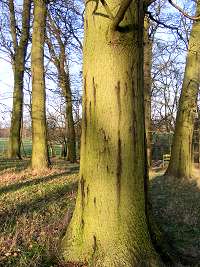Acute oak decline
| Acute oak decline | |
|---|---|
 Stem bleeding in a tree affected with Acute oak decline | |
| Causal agents | Brenneria goodwinii and Gibsiella quercinecans |
| Hosts | Oaks |
| Distribution | United Kingdom |
Acute oak decline (AOD) is a disease that infects
Causes of the disease
Acute Oak Decline is a complex tree decline disease[2] that cannot be explained by a single cause. It results from a combination of environmental factors weakening the trees and some biotic factors.
Bacterial pathogens
Two different species of bacteria, Brenneria goodwinii, Gibbsiella quercinecans, are repeatedly found in the decaying tissues of trees with AOD.
Bark-boring beetle

Most trees affected by AOD will display exit holes and galleries caused by the larvae of the two-spotted oak borer Agrilus biguttatus[7]. Larvea of A. biguttatus and the bacterial pathogens are acting together in causing the disease, with the bacteria being more virulent and causing larger lesions when trees are infected with beetle larvae.[8] Researchers are still investing the potential role of A. biguttatus as a vector of the bacterial pathogens.
Drought and nutrient limitation
As other oak decline disease, AOD usually develops after the tree is being weakened by some environmental factors, called predisposing factors, such as water and nutrient limitation.[9]
See also
- Sudden oak death
- Ash dieback
- Dutch elm disease
- Kauri dieback
References
- ^ "Symptoms of chronic oak decline". Forest Research. Retrieved 2009-09-26.
- ISBN 978-0-323-85042-1, retrieved 2024-01-19
- PMID 28623563.
- PMID 29028005.
- PMID 27553488.
- PMID 29378627.
- ISSN 0015-752X.
- PMID 32811286.
- .
Further reading
- Brady, C.; Denman, S.; Kirk, S.; Venter, S.; Rodríguez-Palenzuela, P.; Coutinho, T. (2010). "Description of Gibbsiella quercinecans gen. nov., sp. nov., associated with Acute Oak Decline". Systematic and Applied Microbiology. 33 (8): 444–450. PMID 21115313.
